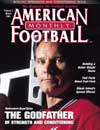AMERICAN FOOTBALL MONTHLY THE #1 RESOURCE FOR FOOTBALL COACHES
Article CategoriesAFM Magazine
|
Future stockIf you want your players to get big and fast, make sure you\'re not stuck in the past. The rules of strength training are changing - rapidly.© More from this issue IT WAS AS TRADITIONAL AS 10-CENT BEER NIGHTS AND double-headers. Before any baseball player stepped into the batter's box, he would put a weight on the end of his bat and take a few cuts, knowing it would make his swing more powerful, faster and increase his chances of popping one over the fence. Then, guess what? Researchers discovered that the once popular bat doughnuts not only didn't help baseball players become home run hitters, they actually hurt them. "It slowed down their swing," says Bill Welle, general manager of Cris Carter's FAST Program in Boca Raton, Fla. Now, instead of swinging weighted bats, baseball players swing small, light, whippy bats known as fungos. Like 10-cent beer nights and double-headers, bat doughnuts are now all-but extinct. And, Welle and other strength coaches expect other traditional exerci....The full article can only be seen by subscribers.
|
|
|||||||
| HOME |
MAGAZINE |
SUBSCRIBE | ONLINE COLUMNISTS | COACHING VIDEOS |
Copyright 2025, AmericanFootballMonthly.com
All Rights Reserved





